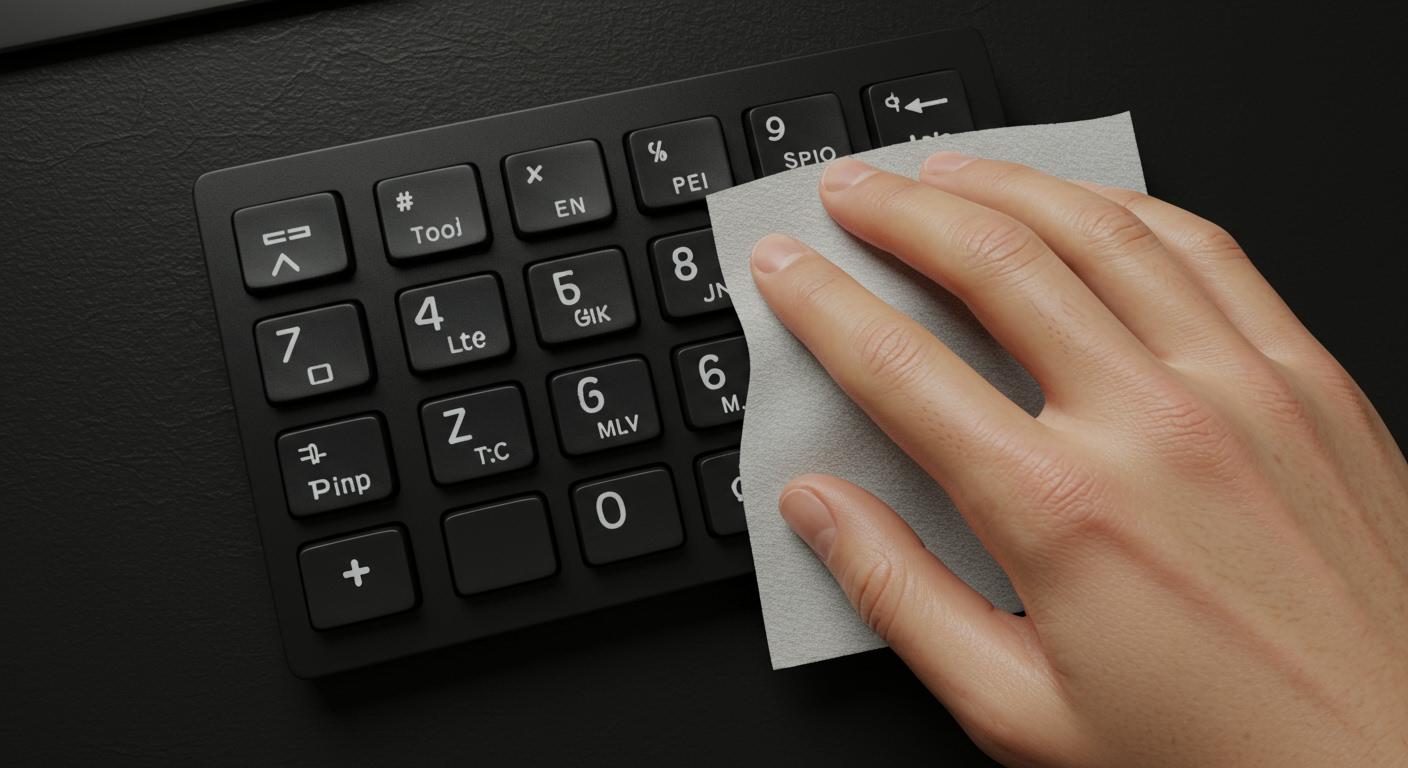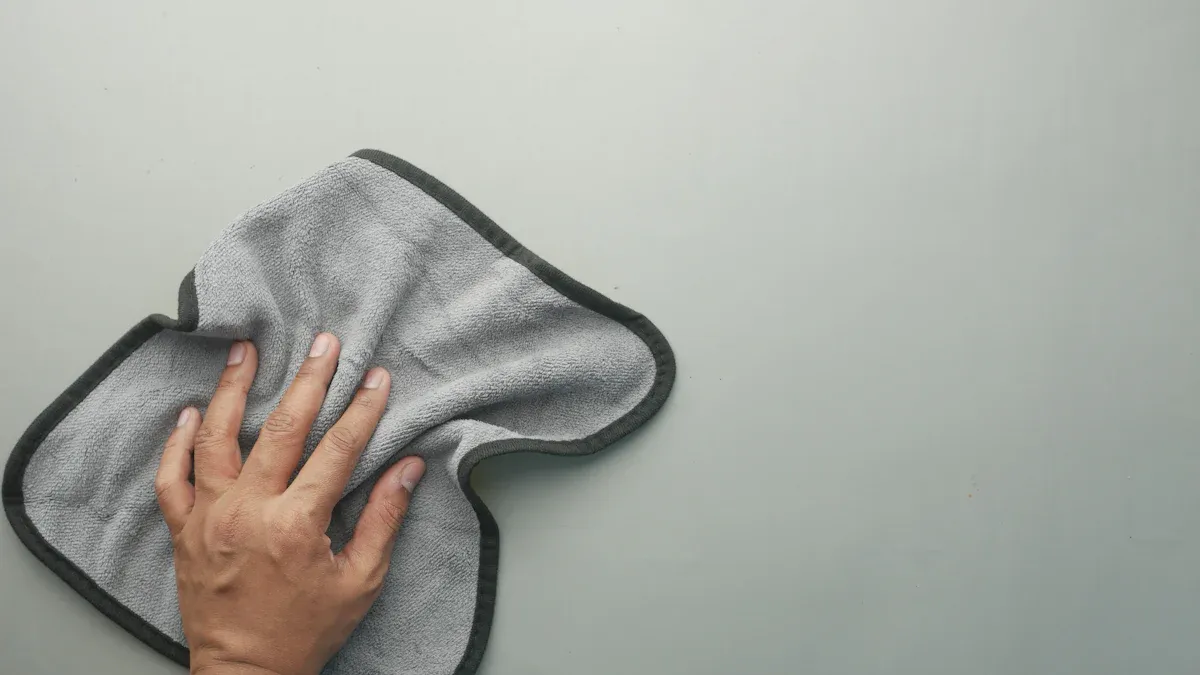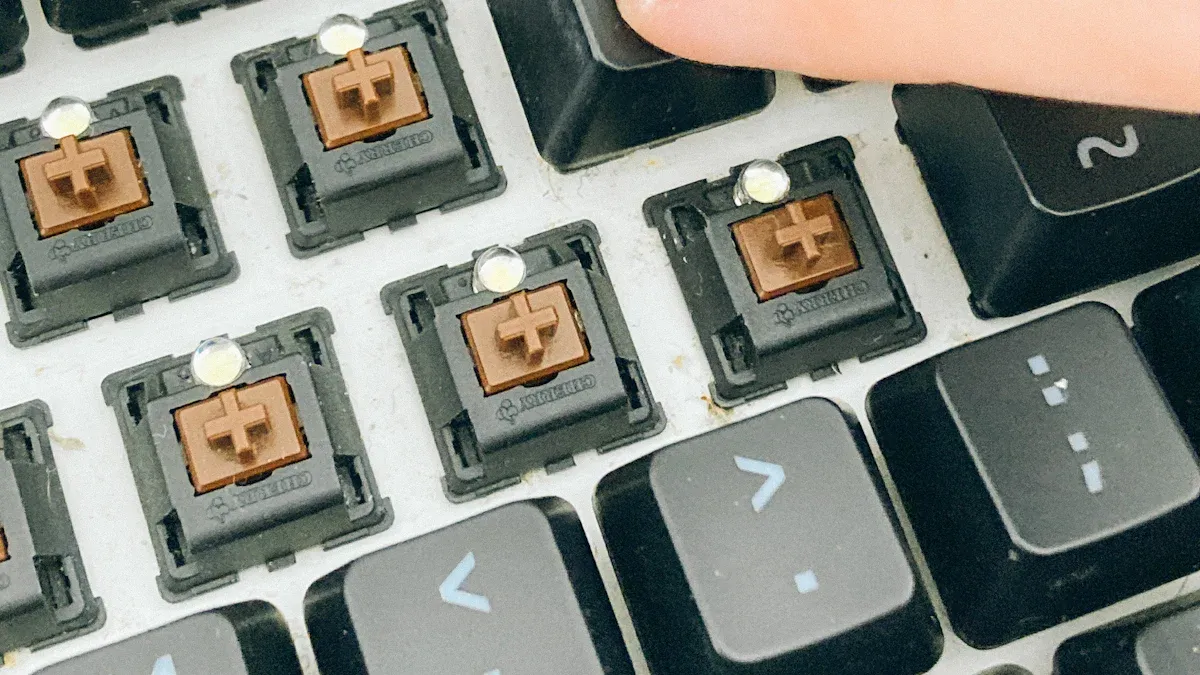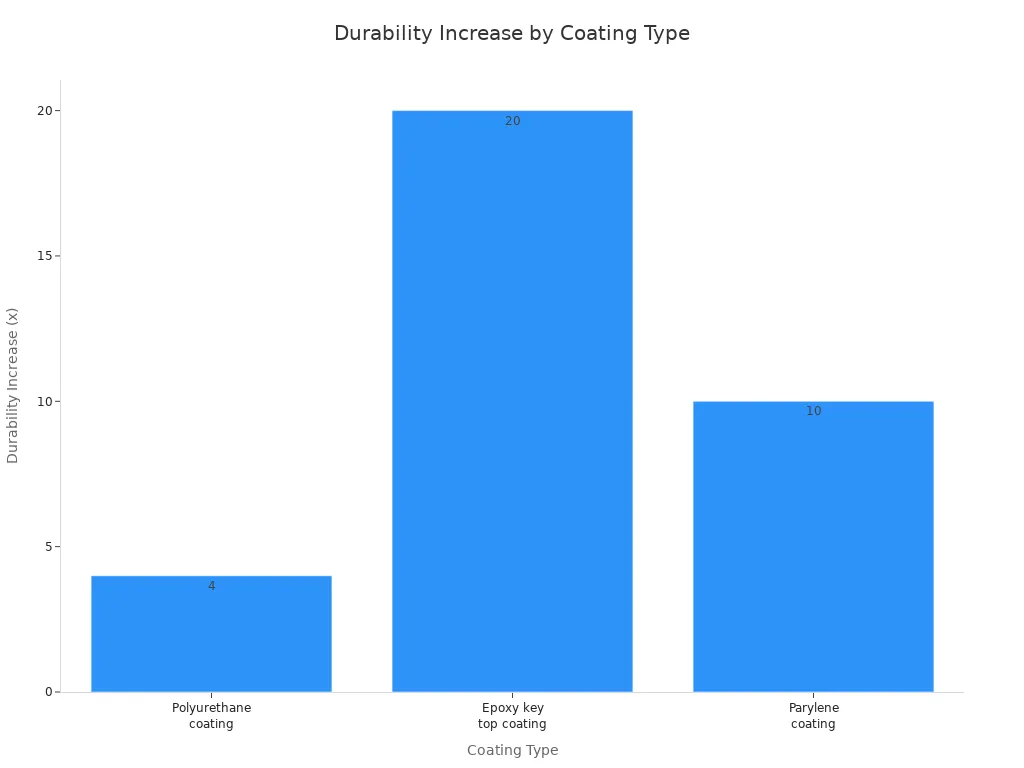
Simple Ways to Keep Your Touch Rubber Keypad Clean
Simple Ways to Keep Your Touch Rubber Keypad Clean

Keeping your touch rubber keypad clean helps your device work well. You will see better use and have fewer problems if you wipe away dust or dirt. Cleaning it often can help your keypad last more years. > You do not need special tools or skills—anyone can do this with easy steps.
Key Takeaways
- Clean your touch rubber keypad often to stop dirt from building up. This helps your device work well and look good.
- Use easy tools like microfiber cloths and isopropyl alcohol wipes to clean. These tools take away dust and germs but do not hurt the keypad.
- Do not use strong chemicals or too much water when you clean. Gentle cleaners keep the rubber safe and help the keypad last longer.
- Make a cleaning plan that fits your space. Clean once a week at home or every day in shared places to keep things clean and working well.
- Turn off your device before you clean it. This keeps you and your device safe from harm.
Why Clean Your Touch Rubber Keypad
Prevent Dirt Buildup
You use your touch rubber keypad a lot. Dirt, dust, and germs can gather on it. These things do not just make it look messy. They can also make your device act up. Dust and dirt can get inside the keypad. This might cause the keys to not work right. Sometimes, the switches may not work when you press them. If you use your device outside, it can get even dirtier. This can cause problems that might not go away. Cleaning your keypad helps stop these issues. It keeps your device working well.
- Common contaminants found on keypads:
- Dust and dirt
- Germs from hands
- Debris from the environment
Improve Performance
A clean keypad works better for you. When you get rid of dirt, the keys work faster. They also work more correctly. This is important for human machine interfaces. You want the keys to be easy to use. If dirt builds up, some keys may not work right. Your device might slow down or stop working. Cleaning your keypad helps it work as it should.
Tip: Clean your keypad often to stop problems early. You will see it works better and misses fewer key presses.
Extend Lifespan
You want your device to last a long time. Cleaning your keypad helps it stay strong. Most silicone keypads break because they get old. This can make the contacts not work well. It can also cause the strips to rust. Cleaning stops dust and dirt from building up. This helps the keys and membrane last longer. Makers say to clean gently and check your keypad often. This keeps it safe from harsh things. If you do this, your device can work well for many years.
What You Need to Clean

Cleaning Tools
You do not need fancy equipment to keep your touch rubber keypad clean. Many experts recommend simple tools that you can find at home or in most stores. These tools help you remove dust, dirt, and fingerprints without harming your device.
- Air duster: This tool uses compressed gas to blow away dust and small particles from the surface and between the keys. It works well for delicate areas.
- Isopropyl alcohol wipes: These wipes clean off fingerprints and sticky spots. They do not leave lint behind, so your keypad stays smooth.
- Soft microfiber cloth: This cloth gently wipes away smudges and dust. It will not scratch the rubber surface.
- Small soft brush: A brush helps you reach into corners and between keys where dirt can hide.
Tip: Always use gentle motions when cleaning. Pressing too hard can damage the rubber.
Safe Solutions
You want to use cleaning solutions that protect your keypad. Some liquids clean well but do not harm the rubber or electronics. Here is a quick guide:
| Cleaning Solution | Description |
|---|---|
| Isopropyl alcohol (70%) | Effective for oils, dust, and light grime; safe if used sparingly. |
| Mild dish soap with warm water | Ideal for regular maintenance; gentle on materials. |
| White vinegar | Useful for sticky buildup; should be rinsed well afterward. |
| Baking soda paste | Natural option for surface tackiness; safe for silicone. |
| Harsh industrial solvents | Should be avoided as they can break down silicone and ruin the finish. |
You can mix a drop of mild dish soap with warm water for everyday cleaning. For tougher spots, a little isopropyl alcohol works well. Always dry the keypad after cleaning.
What to Avoid
Some products can harm your touch rubber keypad. You should stay away from these substances because they can break down the rubber or leave stains.
- Strong detergents
- Alcohol with high concentration
- Harsh chemicals
If you use the wrong cleaner, the rubber may crack or lose its smooth feel. Stick to gentle solutions and tools for the best results.
How to Clean Touch Rubber Keypad

Prepare Device
First, turn off your device. Unplug it from power. This keeps you safe from shocks. Take out the batteries if you can. You want to protect your device while cleaning. Put your device on a flat, dry spot. Gather all your cleaning tools before you start. You need a soft brush, microfiber cloth, mild detergent, isopropyl alcohol, and disinfectant wipes or spray.
Tip: Always turn off your device before cleaning. This helps stop damage to human machine interfaces.
Remove Debris
Loose dirt and dust can hide between the keys. Use a soft brush or compressed air to clear away dirt. Hold your device so dirt falls away from the keypad. Brush gently to avoid damage. For small spaces, use a cotton swab with cleaning solution. Do not press hard. You want your touch rubber keypad to last.
- Use a soft cloth or microfiber cloth to gently remove loose dirt.
- Wipe the keypad with a damp cloth, focusing on dirty spots.
- For small spaces, use a cotton swab with cleaning solution.
- For tough stains, use isopropyl alcohol on a cotton swab and rub gently.
Wipe Surface
After you remove dirt, clean the keypad surface. Pick a microfiber cloth for this job. Microfiber cloths do not scratch or leave lint. Use a cloth that is just a little damp with mild detergent. Do not soak the cloth. Wipe each key and the spaces between them. If you find sticky spots, use disinfectant wipes or a cotton swab with isopropyl alcohol.
| Advantages | Common Uses |
|---|---|
| Highly absorbent | Smartphones, tablets, and computer screens |
| Reusable and washable | Camera lenses and glasses |
| Lint-free performance |
Note: Spray disinfectant onto the cloth, not on your device. This lets you control the liquid and keeps moisture out of the interfaces.
Deep Clean
Sometimes, your touch rubber keypad needs a deeper clean. Mix a drop of mild dish soap with warm water. Dip your microfiber cloth in the mix and wring it out so it is just damp. Wipe the keypad gently. For tough stains or sticky spots, use isopropyl alcohol on a cotton swab. Rub the area with care. You can disinfect the keypad by spraying disinfectant on the cloth. Never spray directly on the keypad. This step helps remove germs and keeps your interfaces safe for everyone.
Dry and Reassemble
After cleaning, you need to dry your touch rubber keypad. Use a dry microfiber cloth to wipe away moisture. Let the device air dry for a few minutes. Make sure the keypad is totally dry before you put batteries back or plug in your device. Moisture can hurt the computer or electronics inside. Always check for liquid in the small spaces or under the keys.
| Precaution | Description |
|---|---|
| Use a lightly dampened cloth | Make sure the cloth is not too wet to keep moisture out of the system. |
| Avoid excessive moisture | Too much moisture can get inside and damage the device. |
| Apply disinfectant to a cloth | Always spray disinfectant onto a microfiber cloth first, not on your device, to control the liquid. |
- Use a cloth that is just a little damp, not wet.
- Do not use too much liquid when cleaning.
- Spray disinfectant onto a cloth first, not on the device.
Tip: Always make sure your touch rubber keypad is dry before you use it again. This keeps your interfaces working and helps everyone enjoy better performance.
Routine Tips to Clean Your Electronics
How Often
It is important to know when to clean your electronics. How often you clean depends on where you use them. The table below shows how often to clean your touch rubber keypad in different places:
| Environment Type | Recommended Cleaning Frequency |
|---|---|
| Medical and Food-Grade Environments | After every use or between shifts |
| Shared Public Spaces | Daily or multiple times a day |
| Personal Home or Office Use | Weekly for general cleaning; monthly for deep cleaning |
| Industrial/Outdoor Environments | As needed based on exposure to dirt or chemicals |
If you use your device at home or work, clean it once a week. Deep cleaning once a month keeps your keypad working well. In busy or shared places, clean more often to keep everyone safe.
Daily Habits
Doing simple things each day helps keep your touch rubber keypad clean. These steps stop dirt and germs from building up fast:
- Wipe the keypad with a soft, damp cloth every few weeks.
- Dry the keypad after cleaning so it does not get wet.
- Try not to touch the keypad with oily or greasy hands.
- Keep your device in a clean, dry place away from dust.
Tip: Make cleaning and disinfecting your electronics part of your daily routine. This helps keep your device safe for everyone.
Prevent Buildup
You can stop dirt from sticking to your keypad by using smart ideas. Pick devices with special coatings or sealed surfaces. Use rubber gaskets or silicone membranes to block dust and water. Clean with gentle solutions so you do not scratch the surface. Some keypads have raised keys or sloped surfaces. These features help water run off and stop dirt from building up.
If you clean and disinfect your device often, your keypad will last longer. Good habits and the right tools make it easy to keep your electronics clean and working well.
Mistakes to Avoid When You Clean
Harsh Chemicals
You might think strong cleaners will make your touch rubber keypad shine. In reality, harsh chemicals can damage the rubber and the sensitive interfaces underneath. Many strong cleaners break down the rubber, causing it to crack or lose its smooth feel. Some products can even leave stains or make the keys sticky. Always choose gentle cleaners like mild soap or a disinfectant spray. These options protect your electronics and keep your keypad safe for every user.
Tip: If you want to disinfect, use a product made for electronics. Spray it on a cloth, not directly on the keypad.
Too Much Moisture
Water helps remove dirt, but too much can harm your device. When you use too much moisture, it can seep into the keypad and reach the computer parts inside. This can cause steel leads to rust, which you may not see right away. Moisture can also weaken the glue that holds the rubber in place. If water gets into the interfaces, it can break the paths that help your keypad work. Always dry your keypad well after you clean. Some experts even suggest drying the circuit board at a low temperature to stop long-term damage.
- Too much water can cause:
- Rust on metal parts
- Damage to the adhesive under the rubber
- Problems with the electronic interfaces
Skipping Cleaning
If you skip cleaning, germs and dirt can build up fast. Unclean keypads can hold harmful bacteria, especially in places like hospitals or public areas. Experts say you should disinfect keypads in patient-care spaces to stop the spread of germs. Regular cleaning keeps your interfaces safe and helps your electronics last longer. When you clean often, you protect yourself and others who use the device.
Remember: A clean keypad works better and keeps every user safe.
Quick Care Checklist
You can keep your touch rubber keypad in top shape by following a simple checklist. These steps help you protect your electronics and make sure your device works well every day.
- Power Down or Unplug
Always turn off your device or unplug it before you start cleaning. This step keeps you safe and protects your computer from damage. - Pre-Wipe
Use a lint-free cloth to gently remove dust and debris from the keypad. Make sure you reach between the keys where dirt often hides. - Apply Disinfectant
Choose a disinfectant spray that matches the manufacturer’s recommendations. Spray it onto a clean cloth, not directly on the keypad. Wipe the surface carefully, making sure you do not let liquid seep into the seams. This step helps you disinfect the keypad and keep it safe for everyone. - Wipe to Dry
Take a fresh, dry cloth and wipe the keypad until it is dry. Avoid using rough pads or paper towels, as these can scratch the rubber surface. - Inspect
Look over your keypad for any signs of wear. Check for loose mounts, stiff keys, or damaged cables. Early detection helps you fix small problems before they affect your device.
💡 Tip: Make this checklist part of your regular routine. Quick care keeps your keypad clean and helps your electronics last longer.
You can print this checklist and keep it near your device. Regular care makes cleaning easy and helps you avoid bigger issues later.
You can keep your touch rubber keypad working well with easy habits. Cleaning it often helps everyone use a device that looks nice and works right. Some coatings, like polyurethane or epoxy, make keypads last longer. The chart below shows how these coatings help.

| Feature | Benefit |
|---|---|
| Resistant to Microbial Growth | Stops germs from growing, so your device stays cleaner. |
| Easy to Clean | Makes it simple to wipe away dirt and spills, so it looks good. |
Try to clean your keypad often. You can also share your cleaning ideas or stories in the comments!
FAQ
How often should you clean your touch rubber keypad?
You should clean your touch rubber keypad once a week for regular use. If you use it in a shared or dirty place, clean it daily. Regular cleaning keeps your device working well and helps stop germs from spreading.
Can you use alcohol wipes on all rubber keypads?
You can use isopropyl alcohol wipes on most rubber keypads. Always check the manufacturer’s instructions first. Some keypads have special coatings that need gentle cleaning. Test on a small spot if you are unsure.
What should you do if liquid spills on your keypad?
Turn off your device right away. Unplug it and remove the batteries. Wipe up the liquid with a dry cloth. Let the keypad air dry completely before you use it again. This helps prevent damage.
Why do some keys feel sticky after cleaning?
Sticky keys often mean you used too much cleaning solution or did not dry the keypad well. Wipe the keys again with a dry microfiber cloth. Make sure no cleaner stays on the surface.
Can you remove the keypad to clean underneath?
Some devices let you remove the keypad for deep cleaning. Check your user manual before you try. If you can remove it, clean both the keypad and the area underneath. Always reassemble carefully.

Top Membrane Switches for Home Electronics Projects in 2025
You can elevate your home electronic membrane switch project in 2025 with standout models such as the 4×4 Matrix 12 Keys Keypad from SOUSHINE, the rgb-enabled strip switches from Molex, and custom graphic switches by Panasonic. These switches offer slim profiles and reliable performance, making them easy to integrate into your DIY setup. You gain ...

Top tips for fixing PS4 controller conductive film keypads
Are you frustrated because your PS4 controller buttons have stopped working? You are not alone. Many gamers experience issues with the conductive film keypad for ps4. Button failures often happen because of dirt, debris, or rough handling. Take a look at the most common causes: Cause Description Dirt and debris Accumulation in button crevices can ...

Top Membrane Switch Companies Leading the Industry in 2025
You see a dynamic market shaping the future of membrane switch technology. Leading companies like Molex, SOUSHINE, YU AN Electronics, TE Connectivity, Honeywell, Omron, Mitsubishi Electric, Panasonic, Industrial Print Technologies, SCHURTER, XYMOX, Douglas Corp, Dyna-Graphics, ELO Touchscreens, UTC, LUNFENG Technology, and Fujikura drive growth with innovation and global reach. Choosing the right membrane switch company ...
Contact us online